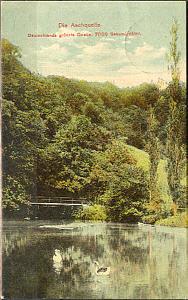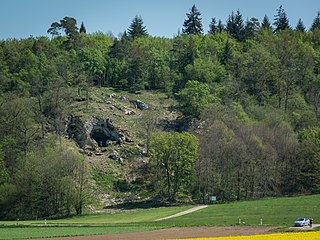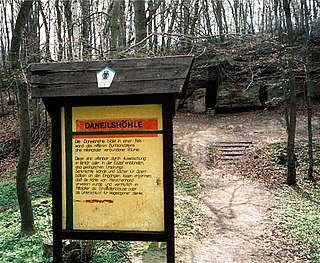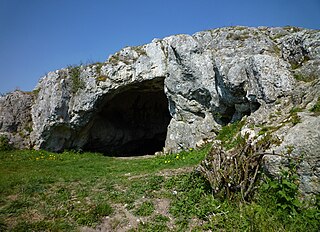 W
WThe list of show caves in Germany contains all 51 show caves in Germany which are hosted by the German Speleological Federation.
 W
WThe Aachtopf (help·info) is Germany's biggest karst spring, located south of the western end of the Swabian Jura, near the town Aach. It produces an average of 8,500 litres per second. Most of the water stems from the River Danube where it disappears underground at the Danube Sinkhole, 12 km North near Immendingen and about 14 km North near Fridingen. The cave system has been explored since 1960´s, but as of 2020 only a small part has been discovered due to a large blockage after a few hundred meters.
 W
WThe Atta Cave or Attendorn Dripstone Cave in Attendorn is one of the largest dripstone caves in Germany.
 W
WThe Balve Cave is the biggest cave used as a cultural venue in Europe. It is located in Balve, Germany.
 W
WThe Barbarossa Cave is an anhydrite cave in the Kyffhäuser Hills near Rottleben in the east German state of Thuringia. It is a cave with large caverns, grottos and lakes. The anhydrite has formed gypsum on the surface due to the air moisture in the cave and, as a result, has increased in volume. The resulting layers of gypsum gradually separate from the underlying rock and hang like wallpaper from the walls and ceilings of the caverns.
 W
WBaumann's Cave, located nearby Hermann's Cave, is a show cave in Rübeland in the district of Harz and is Germany's oldest show cave.
 W
WThe Blauhöhle is the largest cave system in the Swabian Alps in southern Germany. The Blauhöhle presumably originated in a time when the Danube still flowed through the Blau valley. Since the shifting of the Danube, several small rivers, the Schmiech, the Ach, and the Blau, have flowed through this valley. The cave system begins about 21 meters under water at the base of the Blautopf. It continues west and northwest, rising and falling several times until after a horizontal distance of about 1,200 metres (3,900 ft) it comes above the level of ground water and opens into the second big air-filled chamber. The maximum depth of the cave under water is 42 metres (138 ft).
 W
WThe Blautopf is a spring that serves as the source of the river Blau in the karst landscape on the Swabian Jura's southern edge, in Southern Germany.
 W
WThe Bockstein Cave, German: Bocksteinhöhle is part of the Bockstein complex – a White Jurassic limestone rock massif. The 15 by 20 m rock shelter, among small peripheral caves is situated around 12 m (39 ft) above the Lone River valley bottom, north of the towns of Rammingen and Öllingen, Heidenheim district in the central Swabian Jura, southern Germany. Several small openings, that are the actual entrances to the site, lead to various cave sections. The large frontal opening is of modern origin, created during the first excavation works in the late 19th century.
 W
WThe Brillenhöhle is a cave ruin, located 16 km (9.94 mi) west of Ulm on the Swabian Alb in south-western Germany, where archaeological excavations have documented human habitation since as early as 30,000 years ago. Excavated by Gustav Riek from 1955 to 1963, the cave's Upper Paleolithic layers contain a sequence of Aurignacian, Gravettian and Magdalenian artifacts. In 1956 the first human fossils were discovered within a fireplace in the center of the cave, a discovery which made important contributions to the foundational understanding of the Magdalenian culture of central Europe.
 W
WDaneil's Cave, also called Robber's Cave (Räuberhöhle) is located on the northern side of the Huy ridge in the district of Harz in the German state of Saxony-Anhalt. It is named after the legend of a notorious robber, Daneil.
 W
WDas verfluchte Jungfernloch is a small rock cave on the eastern slope of a hill overlooking the Kälbergrund Valley in Eisenach, Germany, roughly 500m south of the Wartburg.
 W
WThe Dechen Cave in Iserlohn, Germany is one of the most visited show caves in Germany. It is located in the northern part of the Sauerland at Iserlohn. 360 metres of the 870-metre long cave have been laid out for visitors, beginning at the spot where, in 1868, the cave was discovered by two railway workers. The workers dropped a hammer into a rock crevice which turned out to be the entrance to a dripstone cave when they were searching for the lost tool.
 W
WThe Devil's Cave is a dripstone cave located in the town of Pottenstein, Bavaria, Germany. The cave is 1,500 metres (4,900 ft) long and is the longest in Germany and the largest in Franconian Switzerland.
 W
WThe Easter Cave is a small cave in the vicinity of Trondorf in Germany. The cave is 185 metres long and may be visited during the summer months. It was first mentioned in the records around 1630. The present entrance was artificially created in 1905 in order to open it as a show cave for visitors. The Easter Cave is one of the last caves in Germany to be lit with carbide lamps. Relatively high concentrations of manganese were found on the walls. The origin of the German name, Osterhöhle, is not entirely clear, but it probably comes from the location of the cave on the Osterberg, a hill whose name in turn may possibly be connected with the German goddess of dawn, Ostara.
 W
WThe Eberstadt Stalactite Cave is a German show cave located in Bauland at the transition of Southeastern Odenwald forest in the North of Baden-Württemberg. It is near Eberstadt, a District of Buchen, around 70 kilometres (43 mi) east of Heidelberg and 100 km (62 mi) north of Stuttgart. The cave is around 600 metres (1,969 ft) long, lies 341 m (1,119 ft) above sea level and is estimated to be 3 to 5 million years old. It was discovered in December 1971 after blasting operations in a Muschelkalk quarry, and opened to the public in 1973. Since then it has been used as a show cave and is one of the attractions of the "Geo-Nature park Bergstrasse-Odenwald".
 W
WThe Erdmannshöhle is a stalactite or flowstone cave in the village Hasel between Schopfheim and Wehr, 20 km east of Lörrach in Baden-Württemberg in Germany.
 W
WGeissenklösterle is an archaeological site of significance for the central European Upper Paleolithic, located near the town of Blaubeuren in the Swabian Jura in Baden-Württemberg, southern Germany. First explored in 1963, the cave contains traces of early prehistoric art from between 43,000 and 30,000 years ago. In 2017 the site became part of the UNESCO World Heritage Site Caves and Ice Age Art in the Swabian Jura.
 W
WThe Heimkehle is one of two great gypsum caves in Germany that are accessible as show caves. It lies on the southern edge of the Harz Mountains between Rottleberode and Uftrungen, east of Nordhausen, right on the state border between Thuringia and Saxony-Anhalt. The cave may be visited as part of a 45-minute-long guided tour.
 W
WHermann's Cave, together with Baumann's Cave, is one of two show caves in the village of Rübeland near the town of Wernigerode, in the district of Harz, Saxony-Anhalt, Germany.
 W
WThe Hohle Fels is a cave in the Swabian Jura of Germany that has yielded a number of important archaeological finds dating from the Upper Paleolithic. Artifacts found in the cave represent some of the earliest examples of prehistoric art and musical instruments ever discovered. The cave is just outside the town of Schelklingen in the state of Baden-Württemberg, near Ulm. In 2017 the site became part of the UNESCO World Heritage Site "Caves and Ice Age Art in the Swabian Jura".
 W
WHohlenstein-Stadel is a cave located in the Hohlenstein cliff at the southern rim of the Lonetal in the Swabian Jura in Germany. While first excavations were started after the second half of the 19th century, the significance of some of the findings was not realized until 1969. The most significant finding was a small ivory statue called the Löwenmensch, which is one of the oldest pieces of figurative art ever found.
 W
WThe Iberg Dripstone Cave is a public cave and geology museum in southern Lower Saxony near Bad Grund, Germany. It is located on the western edge of the Harz mountains in the 563-metre-high (1,847 ft) Iberg mountain at a height of 440 metres (1,440 ft) above sea level in the chalk of an upper Devonian atoll reef. The actual dripstone cave is 123 metres long. With its 78-metre-long (256 ft) Captain Spatzier Gallery, the Yellow Climb and two other caverns, the total length of the cave is 300 metres (980 ft).
 W
WThe Lichtenstein Cave, discovered in 1972, is an archaeological cave site near Dorste, Lower Saxony, Germany with a length of 115 m (377 ft). The skeletal remains of 21 female humans and 19 males, dated to the Bronze Age, about 3,000 years ago were discovered. In addition, around 100 bronze objects and ceramic parts from the Urnfield Culture were found.
 W
WThe Ofnet Caves are the remains of an underground karst system on the edge of the Nördlinger Ries in Germany. They are located on a limestone hill near Nördlingen, Bavaria. The caves became famous in 1908 when 33 prehistoric human skulls were discovered. The skulls were dated to the Mesolithic period.
 W
WThe Riesending cave is a pit cave in Untersberg and the deepest and longest in Germany. It was discovered in 1996. In June 2014 it became well known because of a large effort to rescue a lead speleologist.
 W
WThe Schellenberg Ice Cave is a cave located in the Berchtesgaden Alps in Upper Bavaria, Germany, near the Austrian border. The cave belongs to the Untersberg massif, at 1570 metres above sea level, and is the only ice cave open in Germany. It has an estimated ice volume of about 60,000 cubic meters and has been run as a show cave since 1925. The explored length of the ice cave is 3,621 meters, of which, 500 meters is a guided tour at temperatures near zero degrees Celsius. Closed between October and May, the ice cave can only be reached after a several-hour walk from the valley below, or a slightly shorter walk from the mountain station of the Untersbergbahn. It is one of two show caves in Germany without electric light, illuminated only by carbide lamps carried by the visitors. It is named after Marktschellenberg, a nearby town in Berchtesgadener Land district. In 1826, it was first mentioned in writing, and fully explored by 1874.
 W
WThe small Sirgenstein Cave, German: Sirgensteinhöhle is situated 565 m (1,854 ft) above sea level inside the 20 m (66 ft) high Sirgenstein, a limestone rock. The cave sits 35 m (115 ft) above the Ach River valley bottom in the central Swabian Jura, southern Germany. Archaeologist R. R. Schmidt excavated the site in 1906 during which he identified indices of prehistoric human presence. He recorded the complete stratigraphic sequence of Palaeolithic and Neolithic origin. In his 1910 analysis Schmidt inspired future archaeologists with his pioneering concept of including the excavation site within its geographic region, contextualizing it within a wide scientific spectrum and demonstrated valuable results as he correlated the Sirgenstein layer structure to those of prehistoric sites in France.
 W
WThe Unicorn Cave is the largest show cave in the West Harz, about 1½ kilometres northwest of Scharzfeld in the borough of Herzberg am Harz in central Germany. It is a karst cave developed in dolomite strata that is part of the Zechstein.
 W
WThe Vogelherd Cave is located in the eastern Swabian Jura, south-western Germany. This limestone karst cave came to scientific and public attention after the 1931 discovery of the Upper Palaeolithic Vogelherd figurines, attributed to paleo-humans of the Aurignacian culture. These miniature sculptures made of mammoth ivory rank among the oldest uncontested works of art of mankind. In 2017 the site became part of the UNESCO World Heritage Site "Caves and Ice Age Art in the Swabian Jura".
 W
WVolkmarskeller is the name of a cave that used to have a church next to it in the vicinity of Blankenburg (Harz) in the German state of Saxony-Anhalt.
 W
WThe Wimsener Höhle is Germany´s only water cave, which can be visited by boat. It is located in the municipal area of Hayingen on the Swabian Alb, about three kilometers north of Zwiefalten.